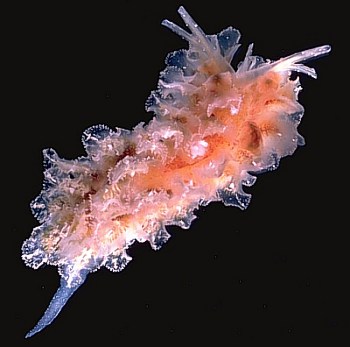
Polybranchia orientalis
(Kelaart, 1858)
Order: SACOGLOSSA
Superfamily: LIMAPONTIOIDEA
Family: Caliphyllidae
DISTRIBUTION
Indo-West Pacific
PHOTO
UPPER RIGHT: Solitary Islands, Coffs Harbour Region, northern New South Wales, Australia, December 1988.
LOWER: Oyster Bay, Dar es Salaam, Tanzania, in pool of Cymodocea, inside algal ridge of reef, May 1973. Closeup on right showing pericardial hump in middle of back and stalked leaf-like cerata on right side of body. The green specks show the fine branching of the digestive gland ducts in the cerata. PHOTOS: Bill Rudman.
Polybranchia orientalis, which was previously know as Phyllobranchus or Phyllobranchillus orientalis is a relatively common member of the Caliphyllidae in the tropical Indo-West Pacific. Members of the family have the back covered in leaf-like cerata, which in Polybranchia and Caliphylla contain fine branching digestive gland ducts, but in Cyerce the digestive gland reaches only into the basal ceratal stalk. The cerata produce sticky secretions from the skin, and in some species, like Polybranchia orientalis, distasteful milky secretions as well, from glands along the edge of the cerata. When disturbed all species are able to cast off their cerata. This is a defensive strategy, called autotomy. New cerata are regrown in a few days.
The main external difference between Polybranchia and Cyerce, is that in Cyerce the sole of the foot has a transverse groove behind the head which is absent in Polybranchia.
Reference:
• Kelaart, E.F. (1858). Description of new and little known species of Ceylon nudibranchiate molluscs and zoophytes. Journal of the Ceylon Branch of the Royal Asiatic Society,
Columbo, 3(1): 84-139.
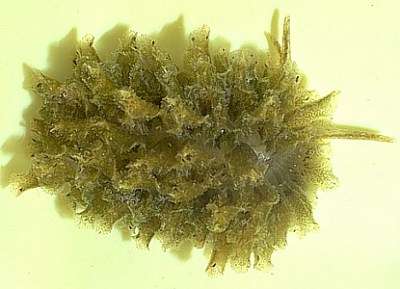
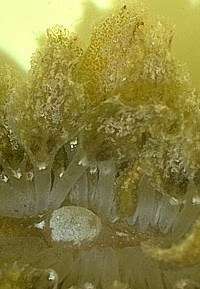
Rudman, W.B., 1999 (July 5) Polybranchia orientalis (Kelaart, 1858). [In] Sea Slug Forum. Australian Museum, Sydney. Available from http://www.seaslugforum.net/find/polyorie
Related messages
Is this poisonous? I think i was stung.
May 5, 2006
From: Leigh Maulson
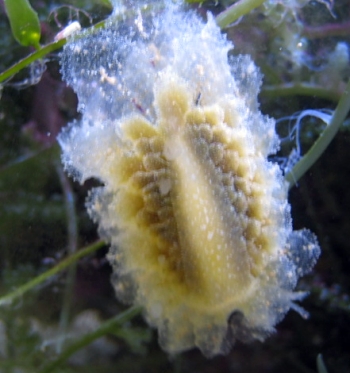
I just found this guy in my planted aquarium. I'm asuming its some sort of pregnant nudibranch.
It's the size of a golf ball. when I touch it, 5 or six of the petals stuck to my finger (engulfed it, i could hardly get them off. they were very very sticky.) I had to wash my hands a few time to remove the residue. The petals that stuck to my finger, seem to move on their own, I'm assuming its a mother :)
To the point, can anybody id this critter? and is it poisonous? since I've touched it my knuckle is a little stiff, and my finger feels wierd. not painful, not ichy, just weird. theres no swelling and no marks.
but i am a little (very little) concerned. thanks.
I cant belive how many nudi's i've found in my planted aquarium since its been set up, however this one truly is a very cool critter.
Leigh Maulson
leighmaulson@rogers.com
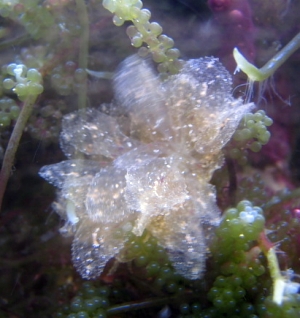

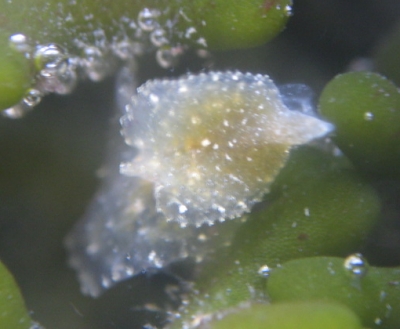
Dear Leigh,
Sorry I didn't reply immediately but I realised you were in no danger from your encounter with your slug. You were 'glued' rather than stung.
By coincidence I am posting a message about the same animal, Polybranchia orientalis, from the Red Sea [message #16492]. As I mention there, this species has the habit of dropping off lots of its leaf-like cerata when it is disturbed. This is a defensive behaviour. When it is nudged or mouthed by a fish or crab, these cerata exude a very sticky substance - which you have experienced - and at the same time drop off the animal and begin wiggling. If you are a fish and suddenly have your mouth and cheeks covered in sticky wiggling objects I guess you loose interest in the animal you were originally investigating.
So that explains your wiggling 'babies' and the stickiness on your fingers. Dropping off parts of your body like this is called autotomy. Have a look at the autotomy Fact Sheet for more examples of this interesting behaviour.
Best wishes,
Bill Rudman
Polybranchia orientalis? from the Red Sea
May 5, 2006
From: Binyamin Koretz
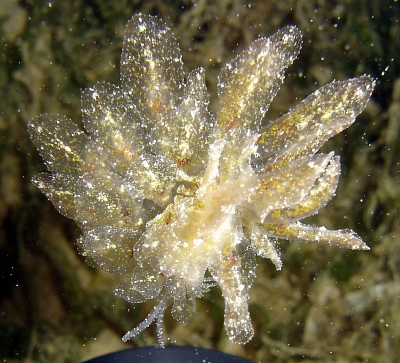
Dear Bill,
We were trying to figure out this fluffy, shapeless slug that Shulamit found in the grass (thinking at first that it was a Cyerce elegans), and as you can see, when I gently prodded it up into the water column for a better look, the results were quite satisfactory. It looks most like Polybranchia orientalis, despite the transparency of the cerata. Do you agree?
Locality: Eilat, Satil Area, 24m, Israel, Red Sea (Gulf of Eilat), 29 April 2006, sea grass and patch reef. Length: 3 cm. Photographer: Binyamin and Shulamit Koretz.
Best regards
Binyamin
binyamin@koretz.net
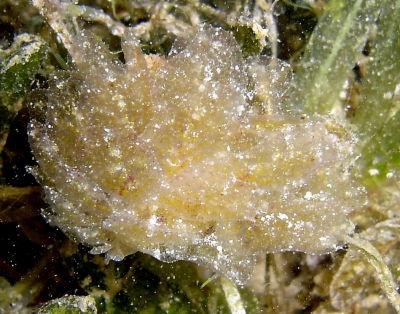
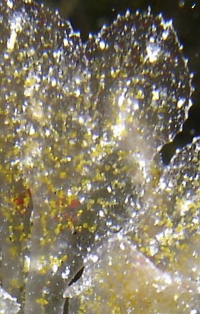
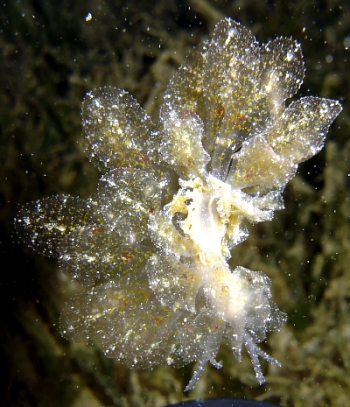
Dear Binyamin,
This is a difficult animal to photograph, because often it will drop most of its cerata if it is disturbed. Yes this is a Polybranchia. The greeny yellow specks in the cerata are the contents of the branching digestive gland ducts and in species of Cyerce the digestive gland doesn't extend past the basal stalk. Another difference is that in Cyerce there is a transverse groove across the sole of the foot just behind the head, which is absent in Polybranchia.
The degree of pigmentation of the cerata is manily dependent on how much food material is in the digestive gland ducts. In recently fed animals the cerata are quite opaque green while in animals which haven't fed for a while are quite transparent.
Best wishes,
Bill Rudman
Polybranchia orientalis from Singapore
July 5, 2005
From: Lim Han Peng
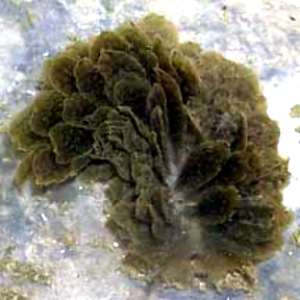
Hi Bill,
During our intertidal walk at our local shores 2 weeks ago, we got an amazing find!! Found this strange looking slug among the sea grass. Need your help to ID it. From the books and yr website, the closest match i could find is a Cyerce elegans or a Polybranchia orientalis. It does have the defense characteristic of Cyerce, shedding its sticky cerata off when we touched it. I am just unsure if a Polybranchia possess the same ability or not. It is not mentioned in any of the websites and books of references that i could find, including your Factsheet as well. Also, we noticed that in the middle of the slug, it was rather bald, without any cerata. Hope that info able to help u in identification.
Locality: Sekudu, Singapore. South China Sea. Depth: 0.3 m. Length: 50 mm. 21 June 2005. Intertidal. Photographer: Ria Tan
hp
limhp@hotpop.com
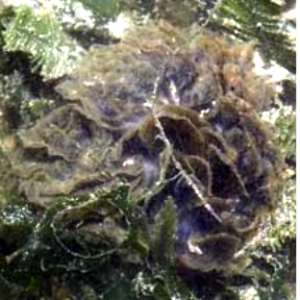
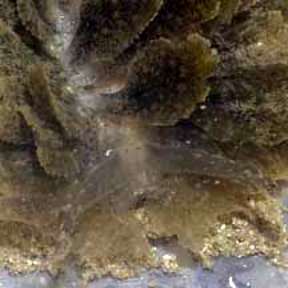
Dear hp,
Yes this is Polybranchia orientalis. Like Cyerce it can also cast off its cerata when disturbed. I was puzzled by your comment that the Fact Sheet doesn't mention it can cast off its sticky cerata - that topic seems to be well covered in the main paragraph.
Best wishes,
Bill Rudman
Sacoglossa from the Philippines
April 19, 2002
From: Erwin Köhler
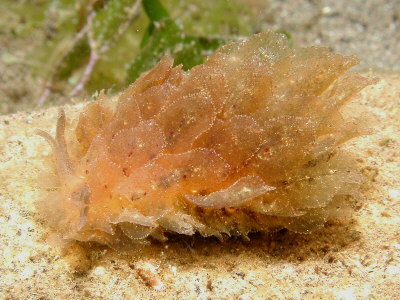
Dear Bill,
here is the next one from the Philippines,
Lipayo, divesite "El Dorado housereef".
Size 67mm, depth 8m, date 07 March 2002
Erwin
Erwin@medslugs.de
Köhler, E., 2002 (Apr 19) Sacoglossa from the Philippines. [Message in] Sea Slug Forum. Australian Museum, Sydney. Available from http://www.seaslugforum.net/find/6766Dear Erwin,
I would call this Polybranchia orientalis. I think it variation in colour from brown to green is related to its food - either the colour of the algae it is eating, or if it is only feeding on green algae then the light brown colouration is a phase at the end of a feeding cycle.
Cheers,
Bill Rudman
Polybranchia orientalis from American Samoa
September 22, 2001
From: Don Barclay
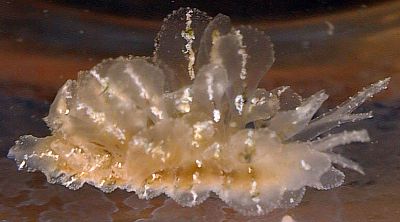
Hello Bill,
Here are a couple of photos of what must be Cyerce elegans. I gave this one a good probing, but couldn't find a trace of the blue spots that are supposed to be characteristic of the species. Most of the cerata had green dendritic-looking structures inside, usually about the middle of each ceras, along with the opaque white branches. The photos show this to some degree, but I had a tough time getting it to really stand out.
Collected early afternoon of 3 August 2001, on algae-covered slab in main surge channel west of the small island, west end of Sailele village, northeast Tutuila, American Samoa. Water 1m deep, animal length 20mm.
Cheers,
Don Barclay
n5ols@samoatelco.com
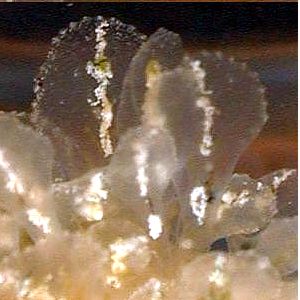
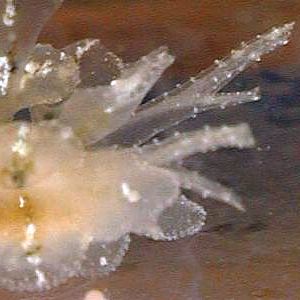
Dear Don,
The reason this looks quite like the relatively transparent Cyerce elegans is that it hasn't had a feed for a while. The specks of green are the last traces of its food, and the branches you mention are branches of the digestive gland which are found in the cerata of Polybranchia but not Cyerce. In the two lower photos I try and show some of the digestive gland branching (LOWER LEFT) and the bifurcating rhinophores (LOWER RIGHT) which are characteristic of the family Caliphyllidae.
I am pretty sure this is a hungry Polybranchia orientalis.
Best wishes,
Bill Rudman
Polybranchia orientalis from eastern Australia
July 5, 1999
From: Grey McNeil
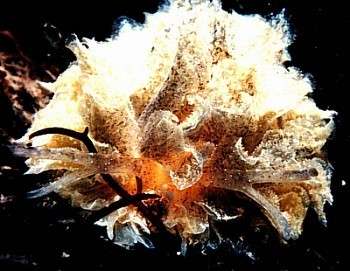
Dear Bill,
Could you identify this photo please. The details are:
FLY PT., NELSON BAY, Port Stephens, NSW, eastern Australia, 5m, March 1998, 5cm long.
Thanks,
Grey McNeil.
GREYMACIND@bigpond.com.au
Dear Grey,
This remarkable animal is the sacoglossan Polybranchia orientalis. Your photo shows it head on so you can see the bifid rhinophores which are characteristic of the Caliphyllidae. Some species, such as this one are well camouflaged, looking much like a clump of brown or green algae, depending on their colour, while others, like Cyerce nigricans have the flashy colours of an animal with nasty secretions in its skin.
All the caliphyllids are able to drop their large flattened cerata when attacked. See the page on autotomy where this defensive strategy is discussed.
Bill Rudman.
Rudman, W.B., 1999 (Jul 5). Comment on Polybranchia orientalis from eastern Australia by Grey McNeil. [Message in] Sea Slug Forum. Australian Museum, Sydney. Available from http://www.seaslugforum.net/find/1003Cyerce and Polybranchia
July 5, 1999
From: Bill Rudman
To accompany the recent messages on the interesting sacoglossans Cyerce elegans and Polybranchia orientalis I have included pages on two other species of the Caliphyllidae.
One species, the spectacularly coloured Cyerce nigricans, is common throughout the Indo-West Pacific and the other, Polybranchia pallens, is endemic to southeastern Australia. It is very similar in shape and colour to Polybranchia orientalis, but differs in having direct developing larvae.
If anyone has a better photo of Cyerce nigricans I would be grateful.
Bill Rudman.
Rudman, W.B., 1999 (Jul 5). Comment on Cyerce and Polybranchia by Bill Rudman. [Message in] Sea Slug Forum. Australian Museum, Sydney. Available from http://www.seaslugforum.net/find/1017